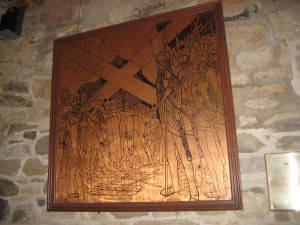
The St Andrew’s Cross or Saltire is Scotland’s national flag. Tradition has it that the flag, the white saltire on a blue background, the oldest flag in Europe and the Commonwealth, originated in a battle fought in East Lothian in the Dark Ages.
It is believed that the battle took place in the year 832AD. An army of Picts under Angus mac Fergus, High King of Alba, and aided by a contingent of Scots led by Eochaidh (Kenneth mac Alpin’s grandfather) had been on a punitive raid into Lothian (then and for long afterwards Northumbrian territory), and were being pursued by a larger force of Angles and Saxons under one Athelstan.
The Albannach/Scots were caught and stood to face their pursuers in the area of Markle, near East Linton. This is to the north of the modern village of Athelstaneford (which was resited on higher ground in the 18th century), where the Peffer, which flows into the Firth of Forth at Aberlady, forms a wide vale. Being then wholly undrained, the Peffer presented a major obstacle to crossing, and the two armies came together at the ford near the present day farm of Prora (one of the field names there is still the Bloody Lands).
Fearing the outcome of the encounter, King Angus led prayers for deliverance, and was rewarded by seeing a cloud formation of a white saltire (the diagonal cross on which St Andrew had been martyred) against a blue sky. The king vowed that if, with the saint’s help, he gained the victory, then Andrew would thereafter be the patron saint of Scotland. The Scots did win, and the Saltire became the flag of Scotland.
When Kenneth mac Alpin, who may have been present with his grandfather at the battle, later united Picts and Scots and named the entity Scotland, Andrew did indeed become the patron saint of the united realm. Kenneth mac Alpin, King of Scots and Picts, Ard-righ Albainn, was laid to rest on Iona in 860AD.